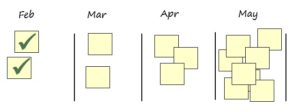Agile projects generally use some form of state-driven planning boards, where each user story moves through a series of states until it reaches “Done”. This is an excellent way to handle work which doesn’t have deadlines prior to release or a lot of interdependencies.
What about projects which do have interim deadlines and interdependencies? Is a visual planning board still useful? For instance, an annual fundraising auction has a drop-dead release date and a lot of dependencies. Some of the planning tasks have their own due dates, such as reserving the venue, contracting with an audiovisual provider, and so forth. Others don’t have fixed due dates, but if you leave them all to the last month, it doesn’t go well. Many of the tasks depend on results from previous tasks.
In projects like this, a calendar-driven planning board is much more effective than the traditional to-do list. At its simplest, a calendar-driven board looks like this.
Each sticky note represents a job which would take no longer than a couple of days. The job is placed in the column indicating when you plan on doing it, and checked off when it’s done. In an auction, there are many tasks which don’t have to be finished until the month before the auction. Teams who plan with a checklist or spreadsheet often don’t realize that they’ve left too much till the end until it’s too late. The visual planning plan makes the monthly workload obvious right away. It’s also simple to grab a sticky note from May and ask “Can we do this one in March? Does it depend on anything else?”
Which type of planning board is right for my project? While both types help prevent taking on too much work at one time, state-driven boards are better at creating “pull” to drive work to completion. Calendar-driven boards handle multiple interim dates and dependencies better. My personal planning board is calendar-driven, but I’d use a state-driven board for a large project like writing a book.
Calendar-driven planning boards are good for projects which:
- Consist mostly of deadline-dependent tasks (must be done every Monday, must be done by Jan 15)
- Have a lot of dependencies – tasks which can’t be started until another task has finished
- Are fairly predictable – you know in advance most of the tasks which will need to be done
- Tend to get into trouble because people leave too much until the last minute
State-driven planning boards are better for projects which:
- Consist mostly of tasks which don’t have to be done in a particular order
- Aren’t very predictable – you don’t know what tasks will be needed to accomplish the end goal
- Require considerable research
- Tend to get into trouble because you put too much on your plate at one time
- Have many tasks which are started but never finished
Read more about state-driven and calendar-driven planning boards in “Simplify Your Management”.